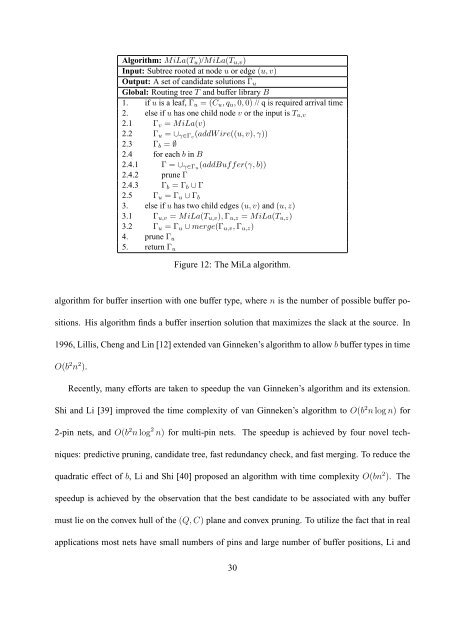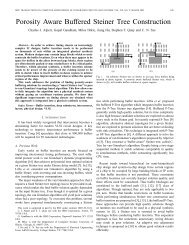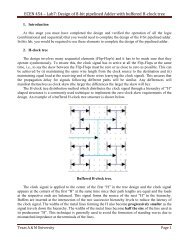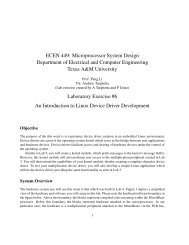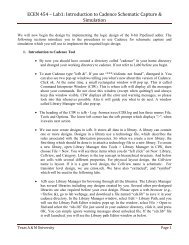Buffer Insertion Basics - Computer Engineering & Systems Group ...
Buffer Insertion Basics - Computer Engineering & Systems Group ...
Buffer Insertion Basics - Computer Engineering & Systems Group ...
You also want an ePaper? Increase the reach of your titles
YUMPU automatically turns print PDFs into web optimized ePapers that Google loves.
Algorithm: MiLa(T u )/MiLa(T u,v )<br />
Input: Subtree rooted at node u or edge (u, v)<br />
Output: A set of candidate solutions Γ u<br />
Global: Routing tree T and buffer library B<br />
1. if u is a leaf, Γ u = (C u , q u , 0, 0) // q is required arrival time<br />
2. else if u has one child node v or the input is T u,v<br />
2.1 Γ v = MiLa(v)<br />
2.2 Γ u = ∪ γ∈Γv (addWire((u, v), γ))<br />
2.3 Γ b = ∅<br />
2.4 for each b in B<br />
2.4.1 Γ = ∪ γ∈Γu (add<strong>Buffer</strong>(γ, b))<br />
2.4.2 prune Γ<br />
2.4.3 Γ b = Γ b ∪ Γ<br />
2.5 Γ u = Γ u ∪ Γ b<br />
3. else if u has two child edges (u, v) and (u, z)<br />
3.1 Γ u,v = MiLa(T u,v ), Γ u,z = MiLa(T u,z )<br />
3.2 Γ u = Γ u ∪ merge(Γ u,v , Γ u,z )<br />
4. prune Γ u<br />
5. return Γ u<br />
Figure 12: The MiLa algorithm.<br />
algorithm for buffer insertion with one buffer type, where n is the number of possible buffer positions.<br />
His algorithm finds a buffer insertion solution that maximizes the slack at the source. In<br />
1996, Lillis, Cheng and Lin [12] extended van Ginneken’s algorithm to allow b buffer types in time<br />
O(b 2 n 2 ).<br />
Recently, many efforts are taken to speedup the van Ginneken’s algorithm and its extension.<br />
Shi and Li [39] improved the time complexity of van Ginneken’s algorithm to O(b 2 n log n) for<br />
2-pin nets, and O(b 2 n log 2 n) for multi-pin nets. The speedup is achieved by four novel techniques:<br />
predictive pruning, candidate tree, fast redundancy check, and fast merging. To reduce the<br />
quadratic effect of b, Li and Shi [40] proposed an algorithm with time complexity O(bn 2 ). The<br />
speedup is achieved by the observation that the best candidate to be associated with any buffer<br />
must lie on the convex hull of the (Q,C) plane and convex pruning. To utilize the fact that in real<br />
applications most nets have small numbers of pins and large number of buffer positions, Li and<br />
30


